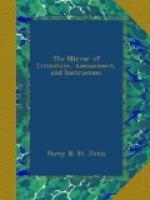[2] We have often seen an etching of this exhibition.
Such was the establishment of this celebrated seminary; and in the humble character of a parochial Free School it long remained, unknown except in its own immediate neighbourhood. The buildings appertaining to the School are not of an ornamental character. The original School-house represented in our engraving, has undergone no external alteration except the necessary repairs. It is a building of red brick having on the top a lion, the rebus of the founder’s name. In the original arrangement of the interior, the lower portions only were used as school-rooms; the middle floor formed the residence of the master and usher, then the only teachers; whilst the upper story consisted of writing schools. The whole of the building is now appropriated to the exercises of the school, the pupils studying their lessons at the houses of their tutors, and assembling here for the purpose of examination.
Harrow is consecrated ground; and we could easily select a long list of illustrious men educated within its walls. The first classical mention of Harrow as a school, is by William Baxter the learned author of the Glossary, and editor of several of the classics, who was educated here. Dr. Bennet, Bishop of Cloyne; Sir William Jones; Dr. Parr, who was born at Harrow; Rt. Hon. R.B. Sheridan; Mr. Perceval, and Lord Byron—shine forth in this list. Earl Spencer; the Marquess of Hastings; the Earl of Aberdeen; and Mr. Peel were likewise educated here.
The greatest number of scholars who have been at any one time at Harrow, was in the year 1804, when the number of students amounted to 353. The present master is the Rev. Dr. Butler.
* * * * *
DR. JOHNSON’S RESIDENCE, IN BOLT COURT.
(For the Mirror)
It perhaps is not generally known, that the residence of the great “leviathan of literature,” situate in Bolt-court, Fleet-street, was consumed by the fire which destroyed Messrs. Bensley’s premises a few years ago; and that there are now no ostensible traces of the doctor’s city retreat, save the site. The only vestige of the house is a piece of grotesquely carved wood, which ornamented the centre of the doorway, and which is now in possession of a gentleman in the neighbourhood. Part of the new printing-office, belonging to Messrs. Mills and Co., occupies a portion of the site, and the remainder forms a receptacle for coals. As if learning loved to linger amidst the forsaken haunts of departed genius, the place is still the scene of those efforts in propagating knowledge, without which it would be a sealed book. When looking upon the scene which has been consecrated by the presence and labours, the joys and sorrows, of such a man, how interesting are our reflections, marred as they may be by mournful impressions of “the mutability of human affairs.”




